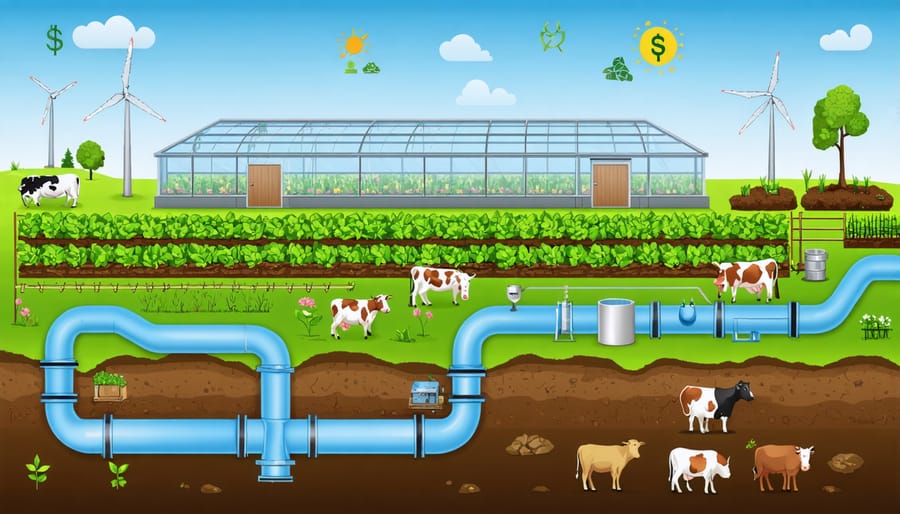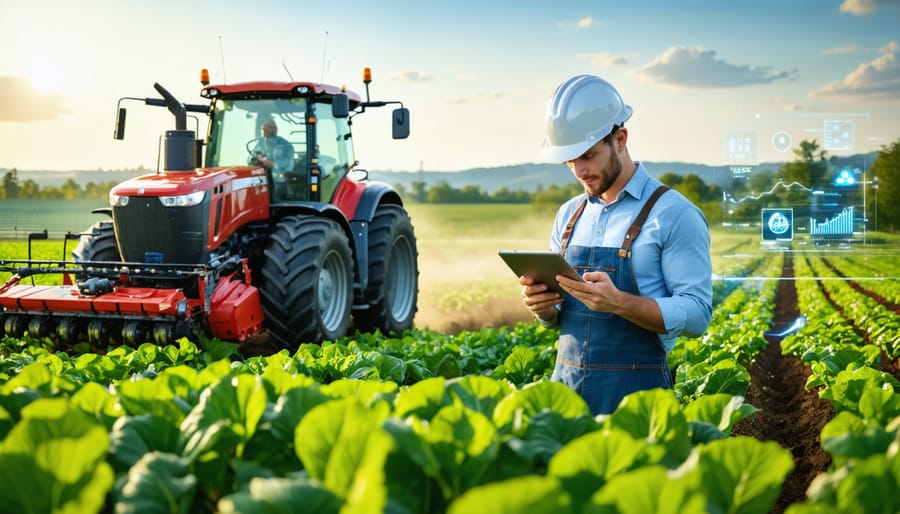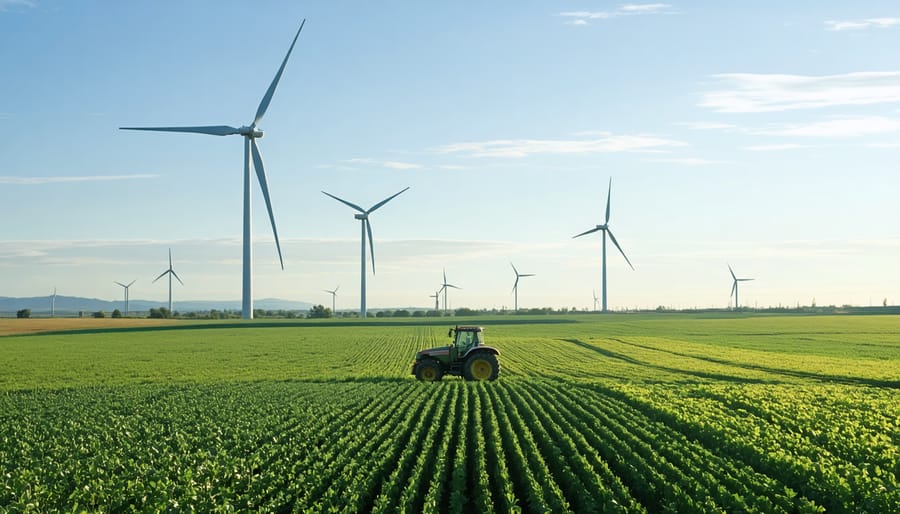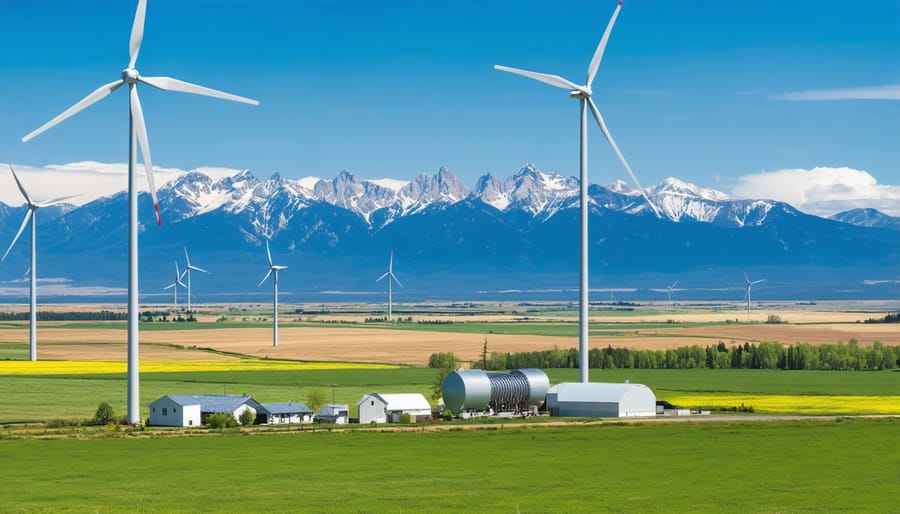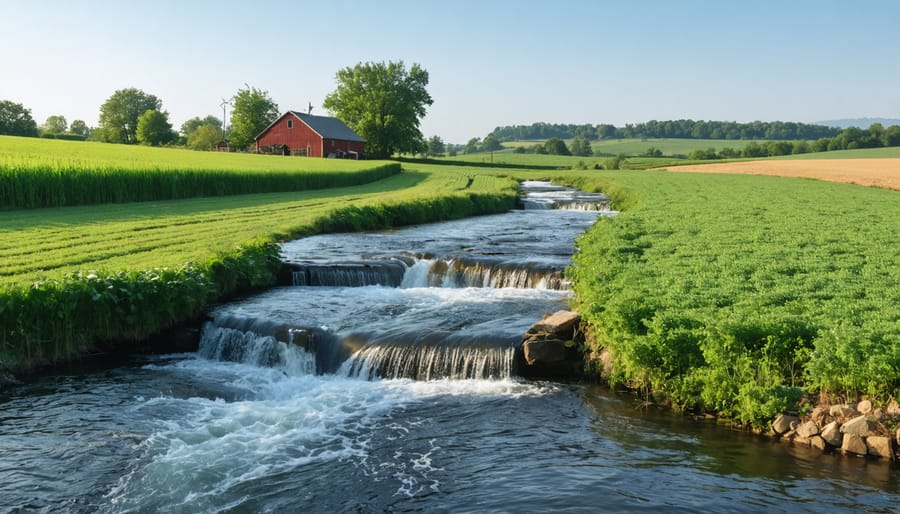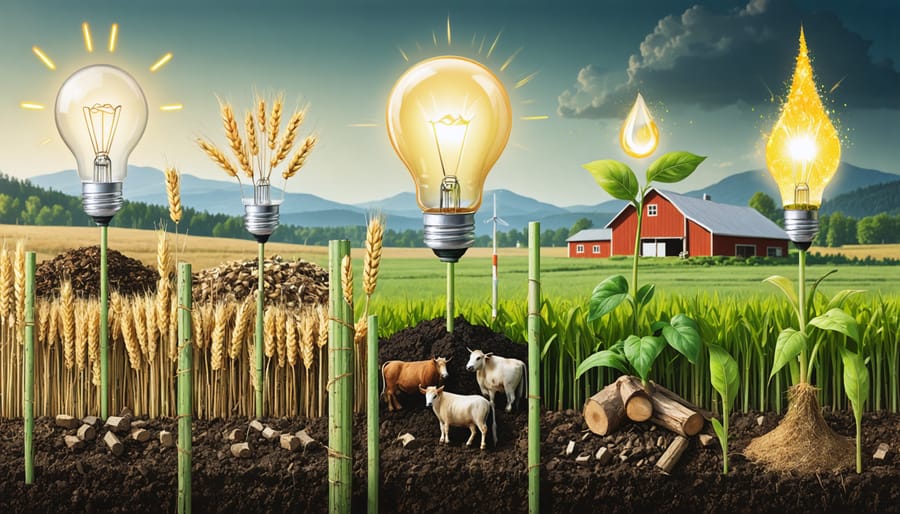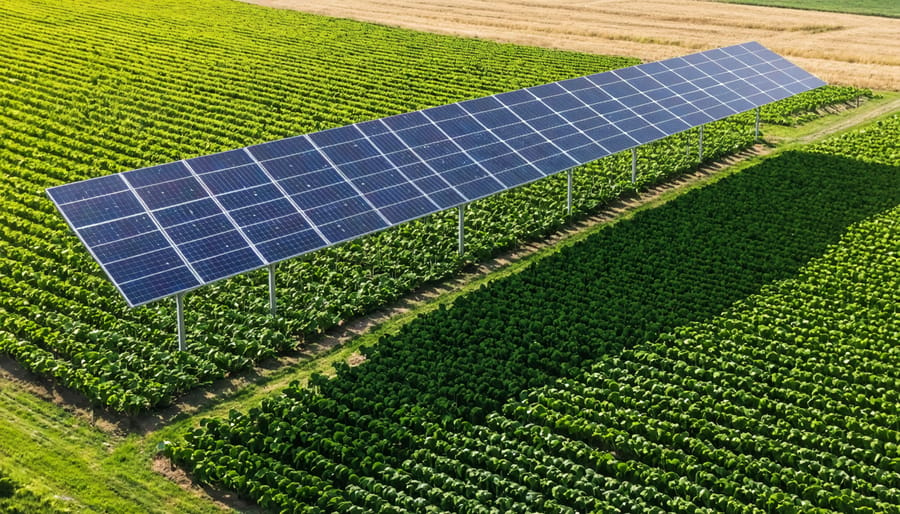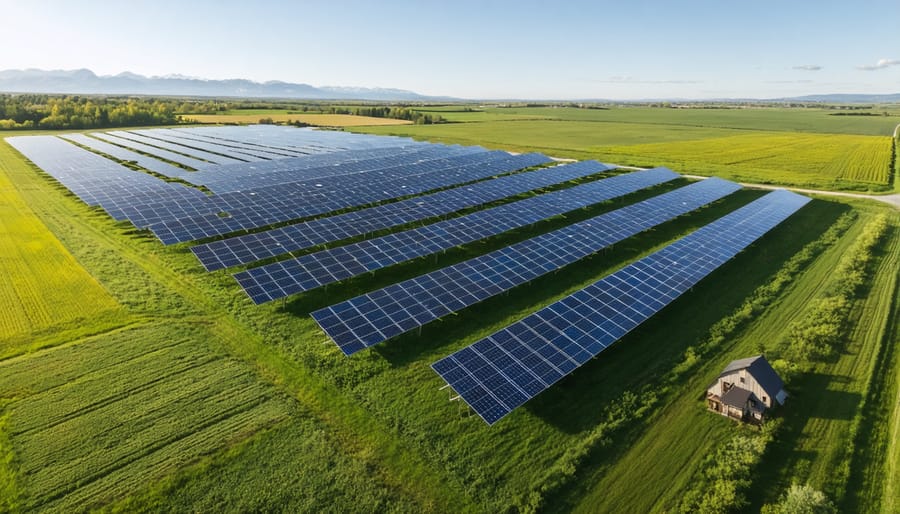Harness Alberta’s untapped geothermal potential to slash farming operation costs by up to 70% through proven ground-source heat exchange systems. Modern geothermal technologies have revolutionized agricultural sustainable energy solutions, delivering consistent, renewable power regardless of weather conditions. Canadian farmers who implement closed-loop geothermal systems report average payback periods of 4-6 years, with systems maintaining peak efficiency for 25+ years when properly maintained.
Unlike conventional heating methods, geothermal energy systems leverage the earth’s constant 10-16°C underground temperature to heat and cool agricultural facilities year-round. This technology proves particularly valuable for greenhouse operations, livestock facilities, and crop storage units across Alberta’s diverse climate zones. Recent advancements in heat pump technology have pushed coefficient of performance (COP) ratings above 4.0, meaning every unit of electrical input generates four units of useful heating or cooling output.
Our province’s unique geological formations, combined with established drilling expertise from the oil and gas sector, position Alberta farmers at the forefront of agricultural geothermal adoption. Local success stories demonstrate how these systems consistently deliver 40-60% energy cost reductions while significantly reducing carbon footprints.
How Geothermal Systems Work on Alberta Farms
Ground Source Heat Exchange Basics
Ground source heat exchange works by tapping into the earth’s constant temperature below the frost line, typically around 10°C in Alberta. A series of pipes, called a ground loop, circulates a mixture of water and environmentally-friendly antifreeze through the soil. As this fluid moves through the pipes, it absorbs heat from the surrounding earth during winter and releases heat during summer.
For farm operations, this system can be configured in either horizontal or vertical layouts, depending on available land space. Horizontal systems are often more cost-effective for farms with ample land, while vertical systems work well in areas with limited surface space. The captured heat is then concentrated through a heat pump and distributed throughout your farm buildings using conventional ductwork or in-floor heating systems.
This technology is particularly effective for maintaining optimal temperatures in livestock barns, greenhouse operations, and storage facilities. Many Alberta farmers find that ground source systems can reduce heating costs by up to 70% compared to conventional systems, while also providing consistent cooling during our hot summer months.
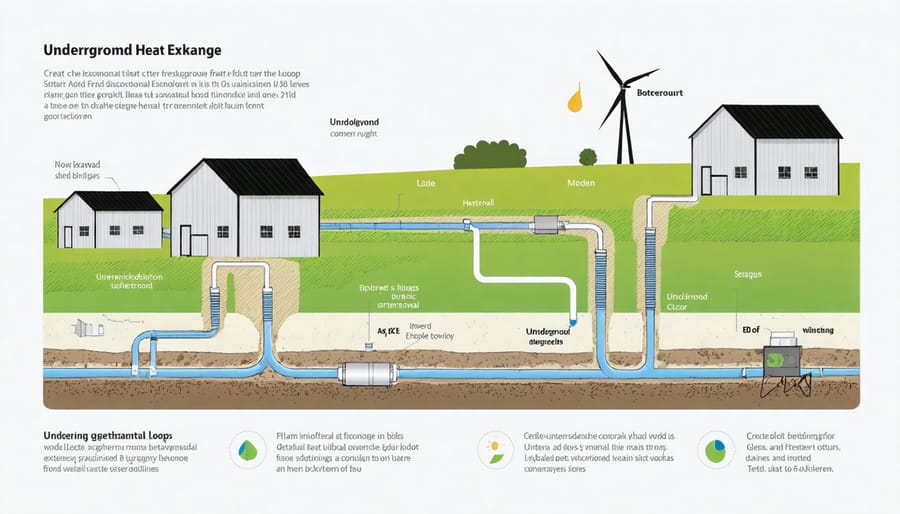
System Components for Agricultural Use
A successful farm-based geothermal system requires several key components working together efficiently. The heart of the system is the ground-source heat pump, which typically ranges from 3.5 to 35 kilowatts for most agricultural applications. These units are specifically sized based on your heating and cooling requirements.
The distribution network consists of high-density polyethylene (HDPE) pipes installed either horizontally or vertically in the ground. For most Alberta farms, horizontal loops installed at 1.8 to 2.4 metres deep work well, though vertical systems might be preferred for properties with limited space.
Essential components include:
– Circulation pumps to move the heat transfer fluid
– Heat exchangers for efficient thermal transfer
– Control systems for temperature regulation
– Backup heating systems for extreme weather conditions
– Distribution manifolds for multiple zone control
For greenhouse operations, additional components often include:
– In-floor heating systems
– Fan-coil units for air distribution
– Humidity control systems
– Smart controllers for automated operation
Many local suppliers now stock these components, making system maintenance and repairs more accessible for Alberta farmers. When selecting components, prioritize CSA-approved equipment rated for Canadian climate conditions.
Maximizing Efficiency in Farm Applications
Greenhouse Climate Control
Geothermal systems have revolutionized greenhouse operations across Alberta, offering farmers a reliable solution for year-round crop production. By tapping into the earth’s constant temperature, these systems provide precise climate control while significantly reducing energy costs. As more producers explore renewable energy for greenhouses, geothermal technology stands out for its consistency and efficiency.
The system works by circulating fluid through underground loops, which maintain temperatures between 10-16°C throughout the year. This stable baseline allows greenhouse operators to fine-tune growing conditions with minimal additional energy input. During winter months, the earth’s heat is extracted to warm the greenhouse, while in summer, excess heat is transferred back into the ground, creating a natural cooling effect.
Local success stories demonstrate the practical benefits. The Morrison Family Farm near Red Deer achieved a 65% reduction in heating costs after installing a geothermal system in their 2-hectare greenhouse operation. Their system maintains optimal growing temperatures of 22°C during the day and 18°C at night, even when outside temperatures drop below -30°C.
The precision control extends beyond temperature regulation. Geothermal systems also help manage humidity levels, typically maintaining 65-75% relative humidity – ideal for most crops. This controlled environment has enabled many Alberta farmers to extend their growing season by up to three months, while some achieve year-round production of certain crops.
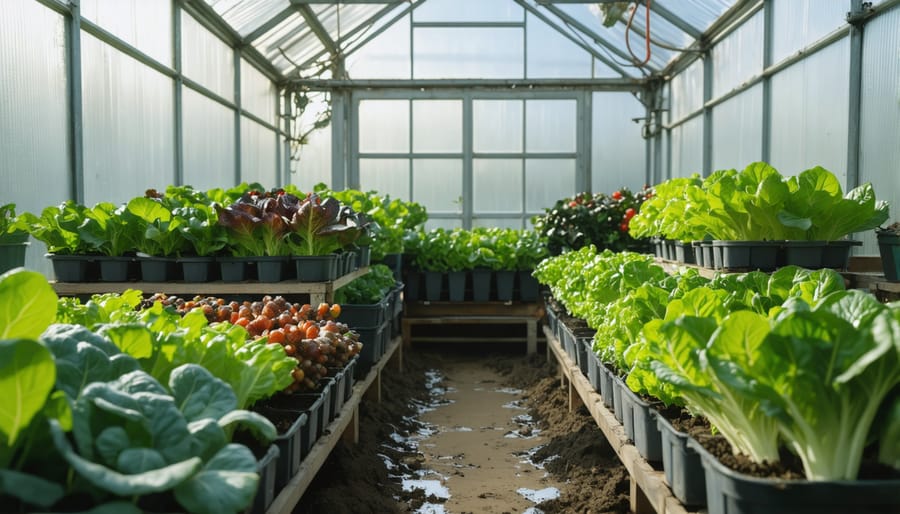
Livestock Facility Temperature Management
Maintaining optimal temperatures in livestock facilities is crucial for animal welfare and productivity, and geothermal systems offer a reliable, cost-effective solution for year-round climate control. These systems can maintain barn temperatures between 10-25°C, creating ideal conditions for livestock throughout Alberta’s extreme seasons.
By tapping into the earth’s constant underground temperature of approximately 10°C at depths of 15-20 meters, geothermal systems can both heat and cool barns with remarkable efficiency. During winter, the system extracts heat from the ground to warm the facility, while in summer, it transfers excess heat back into the earth to cool the space.
Wayne Anderson, a dairy farmer near Red Deer, implemented a geothermal system in his 200-head facility three years ago. “Our energy costs dropped by 60% in the first year,” he reports. “More importantly, our cattle are more comfortable and productive, even during -30°C winter days.”
The initial installation typically requires horizontal ground loops buried across 1-2 hectares of land, depending on facility size. While the upfront cost ranges from $50,000 to $150,000 for most barn installations, farmers can expect payback periods of 5-7 years through reduced energy costs.
Local agricultural extension services offer guidance on system sizing and available grants. Many Alberta farmers have accessed the Canadian Agricultural Partnership program to offset installation costs, making the transition to geothermal more affordable.
Crop Drying and Storage
Geothermal energy offers Alberta farmers a sustainable solution for crop drying and storage, significantly reducing reliance on traditional fossil fuel-based systems. By harnessing consistent underground temperatures, farmers can maintain optimal storage conditions while cutting energy costs by up to 60%.
At the Henderson Family Farm near Red Deer, their geothermal system maintains grain storage facilities at ideal temperatures year-round. “Since installing our geothermal system three years ago, we’ve seen a dramatic improvement in grain quality and storage life,” shares Sarah Henderson, a third-generation farmer. “Plus, our energy bills have dropped substantially during peak drying seasons.”
The system works by circulating fluid through underground loops, which naturally maintains temperatures between 10-15°C. This consistent temperature range is perfect for preventing moisture buildup and reducing the risk of grain spoilage. During harvest season, the same system can be used to aid in crop drying, requiring significantly less additional energy compared to conventional methods.
For smaller operations, modular geothermal systems can be installed incrementally, allowing farmers to scale up as needed. Local agricultural extension offices provide support for system design and implementation, often connecting farmers with qualified installers and available grants.
Remember to conduct regular maintenance checks on your geothermal system, particularly before harvest season, to ensure optimal performance when you need it most. The initial investment typically pays for itself within 5-7 years through reduced operating costs and improved crop quality.
Real Results: Alberta Farm Case Studies
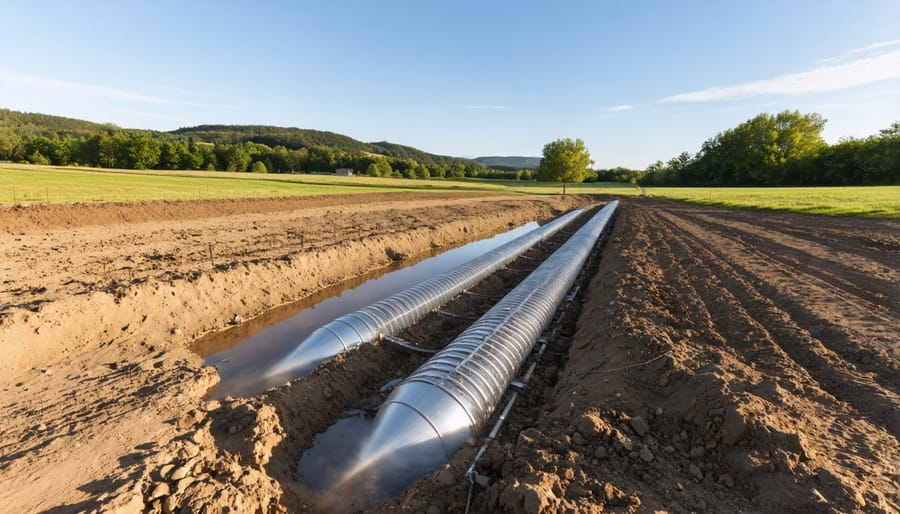
Davidson Family Farm’s Energy Transformation
The Davidson family farm in Red Deer County stands as a shining example of successful geothermal implementation in Alberta’s agricultural sector. In 2019, John and Sarah Davidson made the bold decision to transition their 400-hectare mixed farming operation to geothermal heating and cooling, marking a significant shift in their energy management approach.
The farm, which combines cattle operations with greenhouse production, installed a closed-loop geothermal system utilizing eight 150-meter-deep wells. This system now maintains optimal temperatures in their 2,000-square-meter greenhouse complex and provides heating for their cattle barn and farmhouse.
“The initial investment was substantial,” shares John Davidson, “but we’ve seen our energy costs drop by 65% in the first two years.” The Davidsons worked closely with local contractors and received support through Alberta’s Energy Efficiency Grant Program, which covered 25% of the installation costs.
The system has proven particularly valuable during Alberta’s harsh winters, maintaining greenhouse temperatures at 22°C while outside temperatures plummet to -30°C. The consistent temperature control has enabled the Davidsons to extend their growing season by three months annually, significantly increasing their vegetable production capacity.
Today, the Davidson farm serves as a learning hub for other Alberta farmers interested in geothermal energy. They regularly host farm tours and educational sessions, sharing their experiences and helping others understand the practical aspects of geothermal implementation in agricultural settings.
Red Deer Valley Greenhouse Operations
The Red Deer Valley Greenhouse operation stands as a testament to the transformative power of geothermal energy in Canadian agriculture. By tapping into the earth’s natural heat, this innovative facility has achieved year-round production in Alberta’s challenging climate, maintaining optimal growing temperatures even during harsh winter months.
The greenhouse complex utilizes a closed-loop geothermal system that draws heat from 150-metre-deep wells. This sustainable heating solution maintains temperatures between 20-25°C throughout the year, creating ideal conditions for growing vegetables and herbs regardless of external weather conditions.
Since implementing geothermal technology in 2019, the operation has reduced its heating costs by approximately 70% compared to traditional natural gas systems. The consistent temperature control has also led to a 40% increase in crop yields and enabled the cultivation of heat-loving crops previously impossible in the region.
Local farmer Sarah Thompson, who manages the facility, notes: “We’ve extended our growing season to 365 days a year. What used to be impossible during Alberta winters is now our reality. We’re producing fresh, local vegetables even when there’s snow on the ground.”
The success of this project has inspired neighbouring farms to explore geothermal solutions. The greenhouse now serves as a learning centre for Alberta farmers interested in sustainable heating technologies, demonstrating how geothermal energy can revolutionize local food production while significantly reducing operational costs and environmental impact.
Implementation and Cost Considerations
Initial Investment and Available Grants
Initial investment in geothermal systems typically ranges from $20,000 to $40,000 for an average-sized Alberta farm operation, varying based on property size and system requirements. While this may seem substantial compared to other farm energy alternatives, several government programs help offset these costs.
The Canadian Agricultural Clean Technology Program currently offers grants covering up to 50% of project costs for qualifying farms implementing geothermal systems. In Alberta specifically, the On-Farm Energy Management Program provides cost-sharing opportunities of up to $50,000 per project. The Efficiency Alberta initiative also offers rebates for energy assessments and installation costs.
Local agricultural cooperatives have established group buying programs, helping farmers reduce initial costs through bulk purchasing power. Additionally, some equipment manufacturers offer flexible financing options with terms up to 10 years, making the investment more manageable for family farms.
Remember that while upfront costs are significant, most systems pay for themselves within 5-7 years through reduced energy expenses and increased operational efficiency.
Maintenance Requirements and Long-term Savings
Maintaining a geothermal system on your farm is surprisingly straightforward and cost-effective. Unlike traditional heating systems that require frequent maintenance, geothermal systems typically need only annual inspections and occasional filter changes. Most Alberta farmers report spending less than $300 annually on maintenance, which includes professional check-ups and basic upkeep.
The long-term savings are substantial. According to data from the Alberta Farm Energy Program, farms using geothermal systems see an average reduction of 60-70% in heating and cooling costs. For a typical 500-acre operation, this can translate to savings of $4,000-6,000 annually.
Local farmer Jim Peterson from Red Deer County shares, “We invested $25,000 in our geothermal system five years ago. The system paid for itself in just over four years through energy savings, and we’re now saving about $5,200 yearly on operating costs.”
While the initial installation cost may seem high, provincial and federal clean energy incentives can offset up to 30% of the investment. When properly maintained, these systems can operate efficiently for 25-30 years, making them a reliable long-term investment for your farm’s future.
Geothermal energy represents a transformative opportunity for Canadian farmers to revolutionize their operations while contributing to a more sustainable agricultural future. By implementing energy-efficient farming practices, Alberta’s agricultural community can significantly reduce operational costs while maintaining productivity throughout the year.
The benefits of geothermal systems extend far beyond simple cost savings. From maintaining optimal greenhouse temperatures during harsh winters to providing reliable heating for livestock facilities, geothermal technology offers versatile solutions for diverse farming needs. The initial investment, while substantial, is offset by long-term operational savings and increased farm resilience.
As we’ve seen through local success stories, farmers who have embraced geothermal solutions are experiencing reduced energy bills, improved crop yields, and enhanced animal welfare. With available government incentives and support from local agricultural organizations, there’s never been a better time to explore geothermal options for your farm.
We encourage you to connect with local geothermal experts and fellow farmers who have already made the transition. Their experiences and insights can provide valuable guidance as you consider this sustainable energy solution. By investing in geothermal technology today, you’re not just upgrading your farm’s infrastructure – you’re investing in the future of Canadian agriculture and contributing to our collective environmental stewardship.

